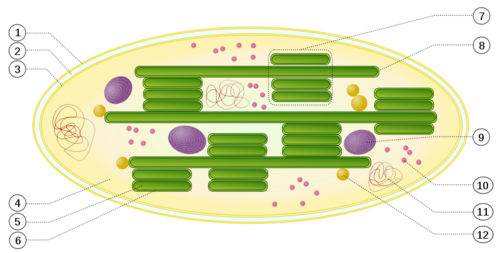Thylakoid: Difference between revisions
imported>Anthony.Sebastian (Using Chris's verb 'bathe', improvement over my 'float', and converting voice from passive to active) |
imported>Anthony.Sebastian (rewrite prokaryote pgraph; add ref with figure showing thylakoid memranes in cyanobacteria) |
||
| Line 2: | Line 2: | ||
Inside [[plant]] [[Cell (biology)|cells]] and other [[Eukaryote|eukaryotic]] cells that perform [[photosynthesis]], tiny, [[bacteria]]-sized [[organelle]]s, called [[chloroplast]]s, contain, within the inner membrane of their dual membrane structure, an extensive system of single-membrane-bound disk-shaped sacs called '''thylakoids''', their interior spaces (lumens) interconnected, their membranes housing the pigment molecules that absorb the [[energy]] of [[photon]]s of particular frequencies emitted by the sun, an event that initiates the physico-chemical sequence of steps culminating in the products of photosynthesis.<ref>[http://users.rcn.com/jkimball.ma.ultranet/BiologyPages/C/Chloroplasts.html Chloroplasts]. | Additional information about chloroplasts and thylakoids.</ref> A semifluid matrix called the [[stroma]] bathes the thylakoids within the chloroplasts. | Inside [[plant]] [[Cell (biology)|cells]] and other [[Eukaryote|eukaryotic]] cells that perform [[photosynthesis]], tiny, [[bacteria]]-sized [[organelle]]s, called [[chloroplast]]s, contain, within the inner membrane of their dual membrane structure, an extensive system of single-membrane-bound disk-shaped sacs called '''thylakoids''', their interior spaces (lumens) interconnected, their membranes housing the pigment molecules that absorb the [[energy]] of [[photon]]s of particular frequencies emitted by the sun, an event that initiates the physico-chemical sequence of steps culminating in the products of photosynthesis.<ref>[http://users.rcn.com/jkimball.ma.ultranet/BiologyPages/C/Chloroplasts.html Chloroplasts]. | Additional information about chloroplasts and thylakoids.</ref> A semifluid matrix called the [[stroma]] bathes the thylakoids within the chloroplasts. | ||
[[Prokayote|Prokaryotic]] cells that carry out photosynthesis (e.g., [[cyanobacteria]]) do not contain chloroplasts; their thylakoid membranes reside within the cytoplasm of the cells.<ref>[http://kentsimmons.uwinnipeg.ca/16cm05/16lab05/lb1pg2.htm Typical cell of a cyanobacterium, a photosynthesis-capable prokaryote]. | |||
*<font face="Gill Sans MT">Scroll down to Figure 4, showing the thylakoids, labelled 'photosynthetic membranes', as extensions of the cell membrane. Although cyanobacteria contain no chloroplasts, the cells themselves resembles eukaryotic chloroplasts.</font></ref> <ref name=barton2005>Barton L. (2005) [http://dx.doi.org/10.1007/b138652 ''Structural and functional relationships in prokaryotes'']. New York: Springer, ISBN 9780387271255. | Discusses thylakoids in cyanobacteria</ref> | |||
In general terms, the photosynthetic process enables the energy of photons radiated from the sun to energize electrons in special photon-absorbing pigment molecules embedded in the thylakoid membranes, electrons ultimately supplied by the splitting of water molecules in a reaction that also converts water's oxygen atoms to molecular oxygen for release into the atmosphere and for use by the plant. | In general terms, the photosynthetic process enables the energy of photons radiated from the sun to energize electrons in special photon-absorbing pigment molecules embedded in the thylakoid membranes, electrons ultimately supplied by the splitting of water molecules in a reaction that also converts water's oxygen atoms to molecular oxygen for release into the atmosphere and for use by the plant. | ||
Revision as of 22:11, 18 November 2010
Inside plant cells and other eukaryotic cells that perform photosynthesis, tiny, bacteria-sized organelles, called chloroplasts, contain, within the inner membrane of their dual membrane structure, an extensive system of single-membrane-bound disk-shaped sacs called thylakoids, their interior spaces (lumens) interconnected, their membranes housing the pigment molecules that absorb the energy of photons of particular frequencies emitted by the sun, an event that initiates the physico-chemical sequence of steps culminating in the products of photosynthesis.[1] A semifluid matrix called the stroma bathes the thylakoids within the chloroplasts.
Prokaryotic cells that carry out photosynthesis (e.g., cyanobacteria) do not contain chloroplasts; their thylakoid membranes reside within the cytoplasm of the cells.[2] [3]
In general terms, the photosynthetic process enables the energy of photons radiated from the sun to energize electrons in special photon-absorbing pigment molecules embedded in the thylakoid membranes, electrons ultimately supplied by the splitting of water molecules in a reaction that also converts water's oxygen atoms to molecular oxygen for release into the atmosphere and for use by the plant.
The thylakoid membranes also contain molecular clusters that transfer the energy of the energized electrons to energy-carrier molecules, the energy therein used in metabolic reactions in the stroma to synthesize organic compounds using the inorganic carbon compound, carbon dioxide, as the carbon source starting material.[4]

Schematic of a chloroplast: 1. outer membrane; 2. intermembrane space; 3. inner membrane (1+2+3: envelope); 4. [stroma (aqueous fluid); 5. thylakoid lumen (inside of thylakoid); 6. thylakoid membrane; 7. granum (stack of thylakoids); 8. thylakoid (lamella); 9. Starch; 10. Ribosome; 11. plastidial DNA; 12. plastoglobule (drop of lipids).
The Internet has numerous images of thylakoids of particular instructive value. You will find links to those images on the Gallery subpage.
References
- ↑ Chloroplasts. | Additional information about chloroplasts and thylakoids.
- ↑ Typical cell of a cyanobacterium, a photosynthesis-capable prokaryote.
- Scroll down to Figure 4, showing the thylakoids, labelled 'photosynthetic membranes', as extensions of the cell membrane. Although cyanobacteria contain no chloroplasts, the cells themselves resembles eukaryotic chloroplasts.
- ↑ Barton L. (2005) Structural and functional relationships in prokaryotes. New York: Springer, ISBN 9780387271255. | Discusses thylakoids in cyanobacteria
- ↑ Thylakoid. FT Exploring. Where and how photosynthesis occurs in a typical leaf.